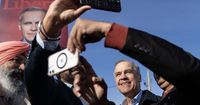As the Canadian federal election heats up, Liberal leader Mark Carney has unveiled an ambitious plan that promises $130 billion in new spending, aiming to reshape the country’s economic landscape. Titled "Unite, Secure, Protect, Build," Carney's platform outlines a strategy that includes significant investments in national defense, healthcare, and infrastructure, while also projecting that Canada will run deficits until at least the fiscal year 2028-2029.
At a press conference in Whitby, Ontario, Carney emphasized that his government would commit more than $18 billion toward national defense, ensuring Canada exceeds its NATO target by 2030. This funding will facilitate the acquisition of new submarines, additional icebreakers for the Royal Canadian Navy, and Canadian-made airborne early warning and control aircraft. According to policy experts who briefed reporters, these expenditures are critical as Canada seeks to bolster its military capabilities amidst growing global tensions.
However, this ambitious spending plan comes with significant implications for Canada’s fiscal health. The Parliamentary Budget Officer (PBO) has projected a baseline deficit of $46.8 billion for the current fiscal year, which accounts for about 1.47% of Canada’s GDP. As Carney's platform unfolds, the anticipated deficit figures for the next four years are staggering: $62.3 billion in 2025-26, $59.9 billion in 2026-27, $54.8 billion in 2027-28, and $47.8 billion in 2028-29. These figures represent a stark increase from the PBO's baseline, which indicated that the deficit would drop to 1% of GDP next year and remain below that threshold for at least two years.
Despite the projected deficits, Carney insists that his platform will create $500 billion in economic value for Canadians over the next five years. He stated, "In total, our plan over the next five years will create $500 billion dollars in economic value for Canadians." Carney's plan includes generating $20 billion in revenue from Canada's tariff response to U.S. trade policies, which he argues will support affected businesses and workers during the ongoing trade war.
In addition to defense spending, healthcare will see a significant boost with a pledge of $5.4 billion over four years, including $4 billion earmarked for infrastructure improvements. Carney stated, "It’s time to build hospitals so that Canadians have access to the care they need." Although healthcare is primarily a provincial responsibility, Carney's government promises to collaborate with provincial and territorial governments to accelerate these investments, which include building new hospitals and clinics and renovating existing facilities.
Furthermore, the Liberal platform aims to add thousands of new doctors to Canada’s healthcare system by increasing medical school and residency spaces and establishing new medical schools. The plan also includes streamlining the credential recognition system for internationally trained healthcare professionals already residing in Canada, allowing them to contribute to the healthcare system more effectively.
As the election campaign progresses, other parties are also unveiling their platforms. NDP Leader Jagmeet Singh released a fully costed platform on April 19, 2025, in British Columbia, while Conservative Leader Pierre Poilievre is expected to present his "New Canada First Economic Action Plan" soon, following endorsements from former Prime Minister Stephen Harper. The Bloc Québécois was the first party to release a comprehensive platform, which includes a proposal to require any free trade agreement text to be voted on in the House of Commons, highlighting the importance of parliamentary oversight amid the trade challenges posed by the U.S.
Experts are closely monitoring the platforms as they are released, emphasizing the importance of costed plans in the current economic climate. Sahir Khan, executive vice-president of the Institute of Fiscal Studies and Democracy at the University of Ottawa, noted that Canadians want to understand how parties will implement their spending plans, especially in light of U.S. tariffs. He stated, "Everything's about $68 billion worse over the next five years," referring to the analysis of the federal deficit amid the ongoing trade war.
Khan expressed concern regarding the delay in releasing comprehensive platforms, stating that by the time major parties unveil their costed plans, many Canadians will have already cast their ballots during advance voting. He added that the uncertainty stemming from U.S. President Donald Trump's trade policies has made the situation more complex for all parties involved.
As the election date approaches, the stakes are high for all parties. Voters are eager to see how each party plans to address pressing issues, from healthcare to national security, while navigating a turbulent economic landscape. The credibility of each party's platform will be scrutinized, as Canadians seek realistic and actionable plans to secure their economic future.
In an environment where fiscal responsibility is paramount, the discussions surrounding the costed platforms will likely dominate the election narrative. As Carney, Singh, Poilievre, and other leaders present their visions for Canada, the electorate remains poised to evaluate which party can best navigate the challenges ahead, ensuring a prosperous and secure future for all Canadians.




